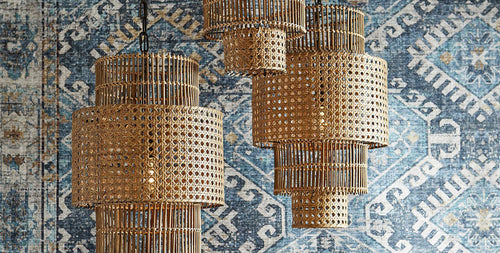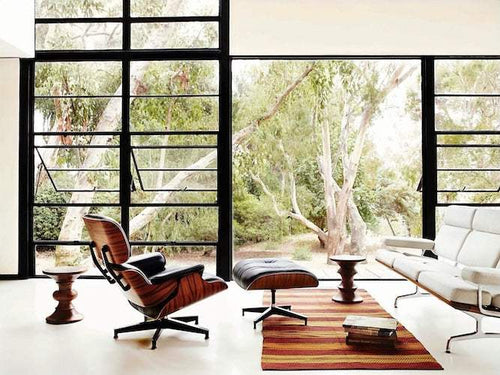First, remove any light bulbs, glass light covers or shades. This will make the fixture easier to handle and prevent broken glass.
Shut off the power to the existing fixture at the breaker box and note the breaker panel number in case you need to turn the power back on later. Then, read the light fixture instructions to see how it is attached to the ceiling box.
Unscrew the Fixture
You need to be able to access the wiring of the existing light fixture before you can install the new one. Turn off the power to your electrical box by turning off the circuit breaker, then remove any decorative pieces and plate that cover the lighting hardware. Be careful when you do this, as many fixtures are heavy. It's a good idea to have someone help you lift them and support them when necessary.

Next, carefully unscrew the caps or connectors that connect the wires coming from the home to the fixture. Then use a voltage tester to make sure there's no electricity running to them. If there is, take a photo of how they're connected so you can refer to it when installing your new fixture.
If there's no current running to the wires, you can simply disconnect the house wiring by unscrewing the wire connectors and untwisting the connections. Be careful not to cut the wires or break them as you do this. A standard junction box will have three sets of wires connected: the black or red current wires, the white neutral wires and the silver or copper grounding wires. Set the fixture aside while you disconnect the wires, and make a note of how they're connected so you can reconnect them properly.
Check the instructions that came with your light fixture to determine how it's attached to the ceiling box. With some styles, the base of the fixture is screwed directly to the ceiling box; with others, a mounting strap is screwed to the box, and then the fixture base is threaded over the strap. If the new fixture requires a strap, examine it closely to find out how it attaches to the box.
If you can't unscrew the cover using your pliers, try using a putty knife or Dremel tool to loosen the cover. You may also need to use a hammer or chisel to break the clip or latch that keeps the cover in place. Once the retainer is loose, the cover should easily slide off the fixture.
Disconnect the Wires
When working with anything electrical, step one is to shut off the power. Head to your fuse box and switch off the circuit that supplies electricity to the room you’ll be working in. If there’s a light fixture attached to this circuit, use your non-contact voltage tester to make sure there’s no current running through it. Then, disconnect the light fixture’s wires from its junction box.
To do this, simply remove the fixture’s canopy (the rounded, broad covering that lies flush with the ceiling and hides all the wiring and hardware). There’s usually some sort of screw holding the canopy in place; undo it to let it drop down. Once it’s dropped, you should see a set of three capped wires in the ceiling: a black hot wire, a white neutral wire, and a green or bare copper ground wire. Note how the wires are connected to each other and the box, so you can reconnect them correctly when you’re ready for your new fixture.
Now it’s time to prepare the new fixture. Unbox it and carefully remove its contents, including the glass shade and any plastic bag containing the fixture’s hardware. Examine the wires and determine how they’re connected to each other and the box – most light fixtures will have three wire leads: a black hot wire, a neutral white wire, and a green or bare conductive ground wire.
You’ll also need to know how to wire the fixture to your home’s electrical system. The best way to do this is by reading the instructions that came with your fixture. It should provide you with a diagram of the wires and how they’re connected, as well as how to connect them to your home’s electrical system.
Generally, you’ll connect the black or red wire from your new fixture to the gold screw in the ceiling box. Then, you’ll connect the white or neutral wire to the silver screw and the ground wire to the green or bare copper screw. You should never mix the wires; connecting a live wire to a neutral or ground would create an electrical short and could shock you or cause a fire.
Remove the Mounting Base
When you're ready to install a new ceiling light, it starts with removing the old fixture from its ceiling support. You'll also need to remove the canopy, which is the rounded covering that lies flush with the ceiling and hides the wiring and fixture hardware underneath it. There's usually some sort of screw holding the canopy in place; undo that to expose the wires and mounting hardware.

With the screws and nuts removed, you can pull up the fixture plate, which will expose the wiring connections in the junction box below it. If the fixture is particularly heavy, it's a good idea to get a friend to help you lift and hold it while you unscrew it. This will make the job much safer and prevent any broken glass from falling onto you.
Once the plate and fixture are removed, you can see a mess of tangled copper wires extending from the ceiling. It's important not to touch these wires. Depending on your location, these wires may carry dangerous voltage or be used to control appliances such as stoves and washers.
Examine the ceiling electrical box and determine if there is a grounding wire present, or if you need to add one. If you need to add a grounding wire, first connect it to a green screw on the metal ceiling box (if there is one), or to the strap that supports the fixture base (if there is a strap).
Next, examine the mounting strap or plate that comes with your new light fixture to see if it has any pre-installed wires, or if you'll need to use wire connectors to attach them. If you're using a strap, the strap should have several small threaded screw holes in it -- some of which are used to attach the strap to the ceiling box, and others that will be used to support the fixture base. If you're using a bracket, the mounting screw holes should match up with the screw holes in the ceiling electrical box. If you're using a strap, connect the exposed end of the black ceiling wire to the bare end of the fixture's black wire, then twist on a wire nut to secure them together. Repeat the process with the white and copper wires.
Reconnect the Wires
Before removing the old fixture, make sure the power is off by turning off the circuit breaker for that room. You should also shut off the light switch so you don’t accidently turn it back on. Once the breaker is off, you can remove the screws that hold the fixture in place and lower it. If your fixture is heavy, you may want to have a friend help support it as you work.

Once the fixture is removed, you can access the wiring that goes to it. The wires should be capped, so you’ll need to unscrew the cap or connector. Once you can see the capped wires, test them with the non-contact voltage tester to ensure there is no current flowing through them. Once you’re certain the circuit is dead, note how the wires are connected. Write down or take a picture to reference later.
The new fixture should come with instructions that specify how it’s attached to the ceiling box. Depending on the style, this could be as simple as screwing the base directly to the ceiling box or as complex as attaching it to a mounting strap that’s already secured to the ceiling box. For example, some straps have threaded holes for a screwed-on metal bracket; the fixture base is then screwed onto that bracket.
After the new fixture is positioned, carefully connect the same-colored wires. If necessary, use wire connectors to ensure a tight connection. Make sure you are connecting to the right wires, and don’t forget to reconnect the grounding wire if it is present (it will have either a black or green wire).
Once the connections are made, you can close up the ceiling box by screwing the decorative plate back into place. If your fixture has a hanging chain, you can adjust it as needed. If the light is still too high, you can raise it by securing it to the ceiling with a bracket that threads onto a protruding mount. Make sure the chain is not sagging. Finally, screw the fixture base into its screw holes and install any light bulbs that are required.



















































